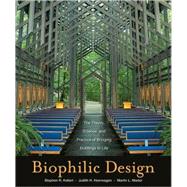
Note: Supplemental materials are not guaranteed with Rental or Used book purchases.
Purchase Benefits
What is included with this book?
Stephen R. Kellert is the Tweedy/Ordway Professor of Social Ecology and Co-Director of the Hixon Center for Urban Ecology at Yale University, and a Partner in the private equity firm Environmental Capital Partners. The recipient of numerous awards for teaching and writing, he is the author of more than 150 publications, including seven books.
Judith H. Heerwagen is President of J.H. Heerwagen & Associates. She is a psychologist whose research focuses on sustainability, biophilia, and the evolutionary basis of environmental aesthetics. She has authored and delivered numerous articles and lectures on the topics of workplace, biophilia, and the psychological value of space.
Martin L. Mador, a researcher on biophilic design at Yale University, has worked on green building and healthy schools issues, including the passage of LEED legislation in Connecticut. He is a board member of the Connecticut Sierra Club, as well as several other environmental organizations.
| Preface | p. vii |
| Acknowledgments | p. xi |
| Prologue: In Retrospect | p. xiii |
| The Theory of Biophilic Design | p. 1 |
| Dimensions, Elements, and Attributes of Biophilic Design | p. 3 |
| The Nature of Human Nature | p. 21 |
| A Good Place to Settle: Biomimicry, Biophilia, and the Return of Nature's Inspiration to Architecture | p. 27 |
| Water, Biophilic Design, and the Built Environment | p. 43 |
| Neuroscience, the Natural Environment, and Building Design | p. 59 |
| The Science and Benefits of Biophilic Design | p. 85 |
| Biophilic Theory and Research for Healthcare Design | p. 87 |
| Nature Contact and Human Health: Building the Evidence Base | p. 107 |
| Where Windows Become Doors | p. 119 |
| Restorative Environmental Design: What, When, Where, and for Whom? | p. 133 |
| Healthy Planet, Healthy Children: Designing Nature into the Daily Spaces of Childhood | p. 153 |
| Children and the Success of Biophilic Design | p. 205 |
| The Extinction of Natural Experience in the Built Environment | p. 213 |
| The Practice of Biophilic Design | p. 225 |
| Biophilia and Sensory Aesthetics | p. 227 |
| Evolving an Environmental Aesthetic | p. 243 |
| The Picture Window: The Problem of Viewing Nature Through Glass | p. 253 |
| Biophilic Architectural Space | p. 263 |
| Toward Biophilic Cities: Strategies for Integrating Nature into Urban Design | p. 277 |
| Green Urbanism: Developing Restorative Urban Biophilia | p. 297 |
| The Greening of the Brain | p. 307 |
| Bringing Buildings to Life | p. 313 |
| Biophilia in Practice: Buildings That Connect People with Nature | p. 325 |
| Transforming Building Practices Through Biophilic Design | p. 335 |
| Reflections on Implementing Biophilic Design | p. 347 |
| Contributors | p. 357 |
| Image Credits | p. 365 |
| Index | p. 371 |
| Table of Contents provided by Ingram. All Rights Reserved. |
The New copy of this book will include any supplemental materials advertised. Please check the title of the book to determine if it should include any access cards, study guides, lab manuals, CDs, etc.
The Used, Rental and eBook copies of this book are not guaranteed to include any supplemental materials. Typically, only the book itself is included. This is true even if the title states it includes any access cards, study guides, lab manuals, CDs, etc.